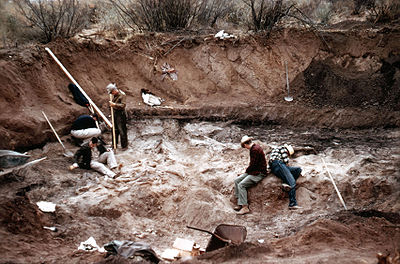
Lehner Mammoth-Kill Site
Encyclopedia
The Lehner Mammoth-Kill Site is a site in southern Arizona that is significant for its association with evidence that mammoths were killed here by Paleo-Indians 9000 years BCE.
In 1952, Ed Lehner discovered extinct mammoth bone fragments on his ranch, at the locality now known as the Lehner Mammoth-Kill Site. He notified the Arizona State Museum
, and a summer of heavy rains in 1955 exposed more bones. Excavations took place in 1955-56, and again in 1974-75. In the first season, two Clovis projectile points were found among the ribs of a young mammoth.
Artifacts found during these excavations included thirteen fluted Clovis culture
projectile points, butchering tools, chipped stone debris and fire hearth features.
Bones of a variety of game—twelve immature mammoth
s, one horse, one tapir
, several bison, one camel, one bear, several rabbits, and a garter snake—were excavated at the Lehner site.
The Lehner Mammoth kill and camp site exhibited a number of firsts: It was the first site associated with the Clovis culture
to have definable fire hearths. These hearths provided the first radiocarbon dates for the culture (9,000 B.C.).
This site was also the first to have butchering tools in direct association with animal remains, and the first Clovis association with small animals, camel, and tapir.
In addition to the obvious artifact remains, an inter-disciplinary group of scientists including archaeologists, botanists, geochronologists, geologists, paleontologists, palynologists, and zoologists have studied and interpreted a wide range of data from the site that greatly adds to our understanding of the past.
The Lehner Mammoth-Kill Site was declared a National Historic Landmark
in 1967.
In 1988, Mr. and Mrs. Lehner donated the site to the Bureau of Land Management for the benefit and education of the public.

In 1952, Ed Lehner discovered extinct mammoth bone fragments on his ranch, at the locality now known as the Lehner Mammoth-Kill Site. He notified the Arizona State Museum
Arizona State Museum
The Arizona State Museum , founded in 1893, was originally a repository for the collection and protection of archaeological resources. Today, however, ASM stores artifacts, exhibits them and provides education and research opportunities. It was formed by authority of the Territorial Legislature...
, and a summer of heavy rains in 1955 exposed more bones. Excavations took place in 1955-56, and again in 1974-75. In the first season, two Clovis projectile points were found among the ribs of a young mammoth.
Artifacts found during these excavations included thirteen fluted Clovis culture
Clovis culture
The Clovis culture is a prehistoric Paleo-Indian culture that first appears 11,500 RCYBP , at the end of the last glacial period, characterized by the manufacture of "Clovis points" and distinctive bone and ivory tools...
projectile points, butchering tools, chipped stone debris and fire hearth features.
Bones of a variety of game—twelve immature mammoth
Mammoth
A mammoth is any species of the extinct genus Mammuthus. These proboscideans are members of Elephantidae, the family of elephants and mammoths, and close relatives of modern elephants. They were often equipped with long curved tusks and, in northern species, a covering of long hair...
s, one horse, one tapir
Tapir
A Tapir is a large browsing mammal, similar in shape to a pig, with a short, prehensile snout. Tapirs inhabit jungle and forest regions of South America, Central America, and Southeast Asia. There are four species of Tapirs: the Brazilian Tapir, the Malayan Tapir, Baird's Tapir and the Mountain...
, several bison, one camel, one bear, several rabbits, and a garter snake—were excavated at the Lehner site.
The Lehner Mammoth kill and camp site exhibited a number of firsts: It was the first site associated with the Clovis culture
Clovis culture
The Clovis culture is a prehistoric Paleo-Indian culture that first appears 11,500 RCYBP , at the end of the last glacial period, characterized by the manufacture of "Clovis points" and distinctive bone and ivory tools...
to have definable fire hearths. These hearths provided the first radiocarbon dates for the culture (9,000 B.C.).
This site was also the first to have butchering tools in direct association with animal remains, and the first Clovis association with small animals, camel, and tapir.
In addition to the obvious artifact remains, an inter-disciplinary group of scientists including archaeologists, botanists, geochronologists, geologists, paleontologists, palynologists, and zoologists have studied and interpreted a wide range of data from the site that greatly adds to our understanding of the past.
The Lehner Mammoth-Kill Site was declared a National Historic Landmark
National Historic Landmark
A National Historic Landmark is a building, site, structure, object, or district, that is officially recognized by the United States government for its historical significance...
in 1967.
In 1988, Mr. and Mrs. Lehner donated the site to the Bureau of Land Management for the benefit and education of the public.
External links
- Bureau of Land Management-Lehner Mammoth Kill Site
- Lehner Mammoth-Kill Site in The Paleo-Indians
- Obituary, Edward Lehner (1914–2003)


